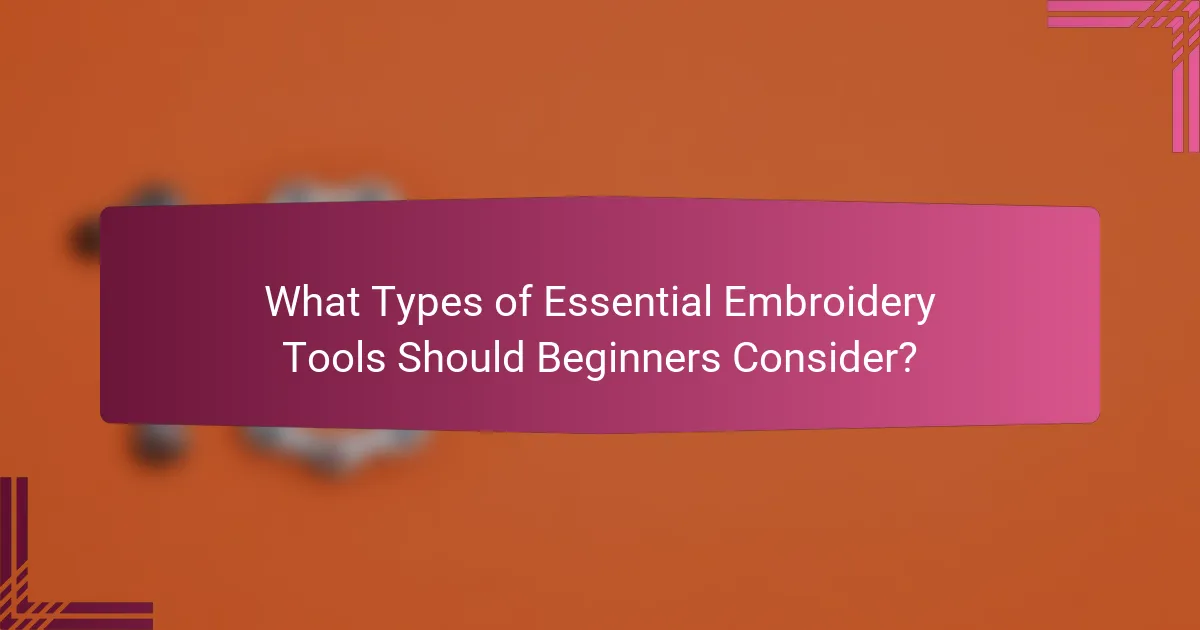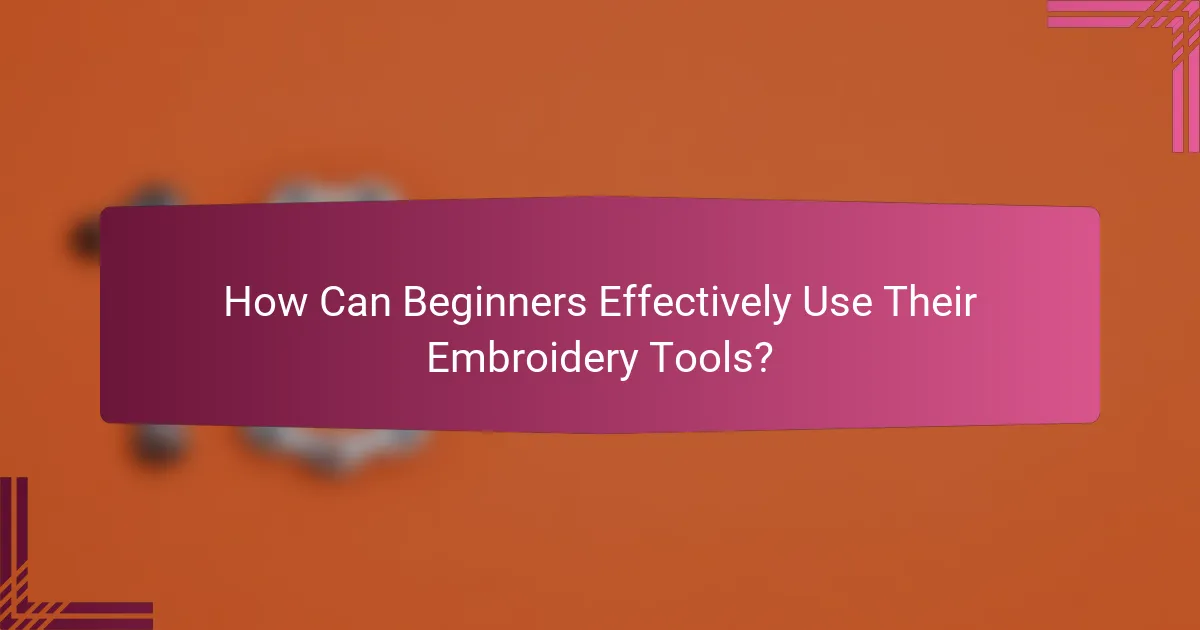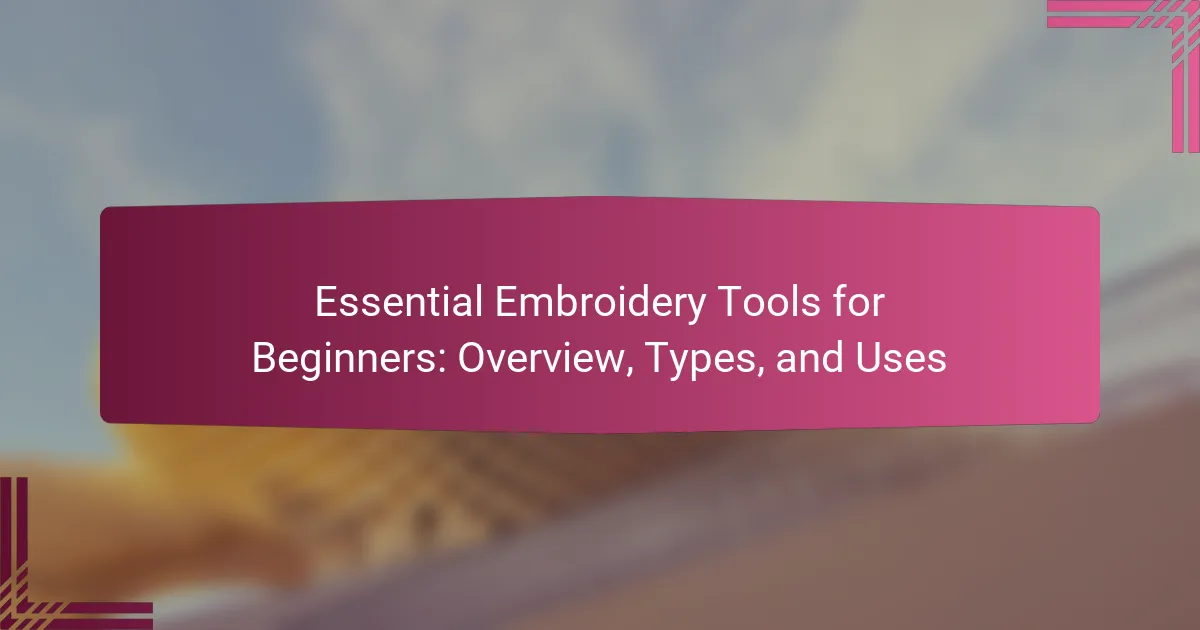
What are Essential Embroidery Tools for Beginners?
Essential embroidery tools for beginners include needles, thread, fabric, embroidery hoops, scissors, and marking tools. Needles are essential for stitching and come in various sizes for different fabrics. Thread is used to create designs and should be chosen based on the project type. Fabric serves as the base for embroidery and can vary in texture and weight. Embroidery hoops hold the fabric taut while stitching, making it easier to work. Scissors are necessary for cutting thread and fabric precisely. Marking tools help in transferring designs onto fabric, ensuring accuracy in stitching. These tools are fundamental for starting embroidery and mastering basic techniques.
Why is it important to have the right tools for embroidery?
Having the right tools for embroidery is crucial for achieving quality results. Proper tools enhance precision and control during the stitching process. They enable the user to execute intricate designs with ease. For example, specialized needles prevent fabric damage and ensure smooth stitching. Quality threads reduce fraying and breakage, contributing to a polished final product. Additionally, ergonomic tools minimize strain and fatigue during long crafting sessions. Using the correct tools can also save time and reduce frustration. Overall, the right tools significantly impact the quality and enjoyment of the embroidery experience.
How can the right tools enhance the embroidery experience?
The right tools can significantly enhance the embroidery experience by improving precision and efficiency. Quality embroidery tools, such as sharp needles and sturdy hoops, ensure clean stitches. Well-designed scissors allow for neat thread trimming, preventing fraying. Specialized threads offer varied textures and durability, enhancing the overall design. Ergonomic tools reduce hand fatigue, making long sessions more comfortable. Additionally, using a reliable embroidery machine can speed up the process and allow for intricate designs. Studies show that using appropriate tools can increase user satisfaction and skill development in embroidery.
What challenges do beginners face without proper tools?
Beginners face significant challenges without proper embroidery tools. These challenges include difficulty achieving precise stitching. Inaccurate stitches can lead to uneven patterns. Additionally, beginners may struggle with fabric handling. Without appropriate tools, fabric can shift during embroidery, causing mistakes. Time efficiency is also affected. Inadequate tools can slow down the embroidery process. Beginners may also experience frustration and decreased motivation. This can result from the inability to produce desired outcomes. Ultimately, lacking proper tools limits skill development in embroidery.
What are the basic categories of embroidery tools?
The basic categories of embroidery tools include needles, threads, hoops, scissors, and stabilizers. Needles vary in size and type for different fabric and thread combinations. Threads come in various materials, including cotton, silk, and polyester. Hoops hold the fabric taut during stitching. Scissors are essential for cutting threads and trimming fabric. Stabilizers provide support to the fabric, preventing distortion during embroidery. Each category plays a crucial role in the embroidery process, ensuring precision and quality in the final product.
What tools fall under hand embroidery essentials?
Hand embroidery essentials include several key tools. These tools are necessary for effective and enjoyable embroidery. Common essentials are embroidery needles, which are specifically designed for hand stitching. Embroidery thread, often made from cotton or silk, is also essential. An embroidery hoop helps keep fabric taut during stitching. Scissors, particularly small and sharp ones, are necessary for trimming threads. Marking tools, such as fabric pens or chalk, assist in transferring designs onto fabric. Lastly, a thimble protects fingers while pushing needles through fabric. These tools facilitate the hand embroidery process and enhance the overall experience.
What tools are necessary for machine embroidery?
The necessary tools for machine embroidery include an embroidery machine, embroidery thread, stabilizers, and scissors. An embroidery machine is essential for creating designs on fabric. Embroidery thread is used to stitch the designs, typically made from polyester or rayon. Stabilizers support the fabric during stitching to prevent puckering. Scissors are needed for trimming threads and finishing touches. Additional tools may include hooping devices and software for design creation. These tools collectively enable successful machine embroidery projects.

What Types of Essential Embroidery Tools Should Beginners Consider?
Beginners should consider basic embroidery tools such as needles, threads, fabric, and hoops. Needles come in various sizes and types suitable for different fabrics. Threads should be of good quality, often made from cotton or polyester. Fabric choices can include cotton, linen, or specialty fabrics for specific projects. Hoops help keep the fabric taut while stitching. Scissors are essential for cutting threads and fabric. Marking tools assist in transferring designs onto fabric. A needle threader can simplify the threading process for beginners. Each tool plays a vital role in successful embroidery projects.
What are the most common hand embroidery tools?
The most common hand embroidery tools include needles, embroidery floss, fabric, scissors, and hoops. Needles are essential for stitching and come in various sizes. Embroidery floss is a six-stranded thread that allows for color variety and texture. Fabric serves as the base for the design and can be cotton, linen, or specialty materials. Scissors are used for cutting threads and trimming fabric edges. Hoops keep the fabric taut during stitching, ensuring even tension. Each of these tools plays a crucial role in the hand embroidery process, making them indispensable for beginners.
How do needles differ for various embroidery techniques?
Needles differ for various embroidery techniques primarily in their size, shape, and eye type. For example, a tapestry needle has a large eye and a blunt tip, suitable for counted thread techniques. In contrast, a sharp needle has a fine point, making it ideal for detailed embroidery work on tightly woven fabrics. A ballpoint needle features a rounded tip, perfect for knits and stretch fabrics to prevent snagging. Additionally, the needle size varies; larger needles accommodate thicker threads, while smaller needles are used for finer threads. Each needle type enhances the technique’s effectiveness and the overall quality of the embroidery.
What types of threads are best for beginners?
Cotton threads are best for beginners. They are easy to work with and widely available. Cotton threads come in various weights, which allows for versatility in projects. Their smooth texture makes them glide easily through fabric. Additionally, they are less prone to tangling compared to other types. Polyester threads are also suitable for beginners. They are strong and durable, making them ideal for various embroidery techniques. Both cotton and polyester threads can be used with most embroidery machines and hand-sewing techniques.
What machine embroidery tools are essential for beginners?
Essential machine embroidery tools for beginners include an embroidery machine, stabilizers, embroidery threads, and needles. An embroidery machine is crucial for creating designs on fabric. Stabilizers support the fabric during stitching, preventing distortion. Various types of stabilizers, such as tear-away and cut-away, cater to different fabrics. Embroidery threads come in various materials, including polyester and rayon, affecting the final look. Needles designed for embroidery have a larger eye to accommodate thicker threads. Additionally, scissors for trimming threads and fabric, along with a hoop to hold the fabric taut, are important tools. These tools collectively enable beginners to effectively start their embroidery projects.
What features should a beginner look for in an embroidery machine?
A beginner should look for user-friendly features in an embroidery machine. Key features include an automatic needle threader, which simplifies setup. A built-in tutorial or guide can assist in learning the functions. An LCD screen is beneficial for easy navigation of settings and designs. Multiple built-in embroidery designs offer variety for practice. Adjustable speed control allows beginners to work at a comfortable pace. A lightweight design enhances portability for easy storage and transport. Finally, a reliable warranty provides peace of mind for new users.
How do stabilizers contribute to successful machine embroidery?
Stabilizers are critical for successful machine embroidery as they provide the necessary support to the fabric during stitching. They prevent distortion and shifting of the fabric, ensuring accurate designs. Different types of stabilizers, such as tear-away, cut-away, and wash-away, serve specific purposes. Tear-away stabilizers are easy to remove after stitching, while cut-away stabilizers offer lasting support for dense designs. Wash-away stabilizers dissolve in water, leaving no trace behind. Proper use of stabilizers enhances stitch quality and reduces puckering. According to the Embroidery Association, using the right stabilizer can significantly improve the final appearance of the embroidery.

How Can Beginners Effectively Use Their Embroidery Tools?
Beginners can effectively use their embroidery tools by first familiarizing themselves with each tool’s purpose. Understanding the function of needles, threads, and hoops is essential. For example, using the correct needle size prevents fabric damage. Thread selection impacts the final design’s appearance and durability. Beginners should practice basic stitches to build confidence. Regularly maintaining tools, such as cleaning needles, enhances performance. Organizing tools in a dedicated space improves accessibility and efficiency. Following instructional resources, like tutorials or classes, increases skill acquisition. These steps create a solid foundation for successful embroidery projects.
What techniques should beginners learn for using embroidery tools?
Beginners should learn basic stitching techniques for using embroidery tools. These techniques include the running stitch, backstitch, and satin stitch. The running stitch consists of simple, evenly spaced stitches. Backstitch provides a solid line, ideal for outlining designs. Satin stitch fills shapes with smooth, flat stitches. Beginners should also practice knotting threads and threading needles. Understanding fabric tension is crucial for even stitching. Learning to hoop fabric properly ensures stability while stitching. Familiarity with different needle types and thread weights enhances overall embroidery quality. These foundational techniques build essential skills for successful embroidery projects.
How can beginners practice their skills with basic tools?
Beginners can practice their skills with basic embroidery tools by starting with simple projects. Using a basic embroidery hoop, beginners can secure their fabric and maintain tension. They should choose easy patterns, such as simple shapes or letters, to build confidence. Basic embroidery floss is recommended for its ease of use and vibrant colors. Beginners can practice fundamental stitches like the running stitch and backstitch to develop their technique. Online tutorials and videos provide visual guidance and step-by-step instructions. Consistent practice will improve their skills over time. Engaging in small projects, like bookmarks or patches, allows for practical application of learned techniques.
What common mistakes should beginners avoid when using tools?
Beginners should avoid using tools without proper instruction. Misusing tools can lead to accidents or damage. Another mistake is neglecting safety precautions. Wearing protective gear is essential to prevent injuries. Failing to maintain tools can also cause issues. Regular cleaning and sharpening enhance tool performance. Additionally, beginners often overlook the importance of choosing the right tool for the task. Using incorrect tools can result in poor quality work. Lastly, rushing through projects can lead to mistakes. Taking time ensures accuracy and better results.
What tips can help beginners choose the right tools for their projects?
Beginner embroiderers should assess their project requirements before selecting tools. Identify the type of embroidery you intend to do, such as hand or machine embroidery. Research the essential tools specific to that technique. Consider the fabric you will use, as different fabrics may require different needles and threads. Evaluate your budget, as tools range from basic to professional-grade options. Seek recommendations from experienced embroiderers or online communities to find reliable brands. Finally, purchase a few tools initially and expand your collection as you gain experience. This gradual approach helps avoid overwhelming choices and ensures you invest in necessary tools.
How can beginners assess the quality of embroidery tools?
Beginners can assess the quality of embroidery tools by examining their materials and construction. High-quality tools are typically made from durable materials like stainless steel or high-grade plastic. Check for comfortable grips, as ergonomic designs enhance usability. Look for smooth finishes that prevent snagging on fabric.
Additionally, beginners should consider brand reputation and reviews from other users. Established brands often have a history of producing reliable tools. Reading user feedback can provide insights into performance and longevity.
Finally, testing tools in-store, when possible, allows beginners to gauge weight and balance. A well-balanced tool feels more comfortable during use.
What budget considerations should beginners keep in mind?
Beginners should consider the cost of essential embroidery tools when budgeting. Basic tools include needles, threads, fabric, and hoops. The total cost can vary widely based on quality and brand. Budgeting for high-quality materials is important for durability. Beginners should also account for additional supplies like scissors and storage solutions. Setting a budget helps prioritize necessary items over optional ones. Researching prices before purchasing can lead to better deals. Beginners may find starter kits that offer a cost-effective way to acquire multiple tools.
Essential embroidery tools for beginners encompass a range of items including needles, threads, fabric, embroidery hoops, scissors, and marking tools. This article provides a comprehensive overview of these tools, detailing their importance for achieving quality results and enhancing the embroidery experience. It categorizes essential tools for hand and machine embroidery, discusses common challenges beginners face without proper tools, and offers practical tips for effective use and selection of tools. Additionally, it covers techniques beginners should learn, common mistakes to avoid, and budget considerations for acquiring quality embroidery tools.
